List of cultural monuments in Sankt Goar
The list of cultural monuments in Sankt Goar includes all the cultural monuments of the Rhineland-Palatinate municipality of Sankt Goar including the districts of Biebernheim , Fellen and Werlau . The basis is the list of monuments of the state of Rhineland-Palatinate (as of August 9, 2017).
Sankt Goar
Monument zones
| designation | location | Construction year | description | image |
|---|---|---|---|---|
| Monument zone castle and fortress Rheinfels | west of the city location |
1245 | one of the largest castle ruins on the Rhine, significant both for the castle building art of the Counts von Katzenelnbogen in the 14th century, as well as for the castle and fortress construction of the 16th and 18th centuries. the Landgrave of Hessen-Kassel founded in 1245 by Count Diether von Katzenelnbogen instead of an older Talburg; in the 13th and 14th centuries expansion into the residence of the Lower Counties, in the 14th and 15th centuries center on the Middle Rhine to the Landgraves of Hesse after the Katzenelnbogen family died out in 1479; 1567–83 residence of Landgrave Philip II of Hesse-Rheinfels, then to Hesse-Kassel; 1626–47 to Hessen-Darmstadt, then again to Hessen-Kassel; In 1692, during the War of the Palatinate Succession, the French siege repulsed; Surrendered to French troops in 1794, gradually demolished from 1796 and used as a quarry; in municipal ownership since 1925 Square core castle with only the foundation preserved; in the 14th century the keep was raised in the shape of a “churn”, “women's building”, shield wall with 2 towers; 1480 to 1527 expansion into a fortress; Neck ditch between core castle and shield wall covered by barrel vaults, Rhine side and to Gründelbachtal Vorwerke, at Biebernheimer Feld external works; around 1570/80 expansion into a Renaissance residence: especially the Rhine wing (“Darmstädter Bau”) equipped with half-timbered buildings (none of them preserved); At the beginning of the 17th century, among other things, mine tunnels; in the second half of the 17th century further expansion, 1657–67 fort “Scharfeneck” and “Noli me tangere”, “Neue Ravelin” (today outside and in private ownership) and “Hohe-Ernst-Schanze” The monument zone includes the fortresses of the mountain on which it stands, and spur-like extends south to the city wall, the rest of which are included in the monument zone. This also includes the Paradeplatz, the so-called “White Villa” or “Gut Rheinfels” (built shortly before 1900 by the manufacturer Reusch; exposed location next to the Rheinfels ruin; plastered building with Gothic elements, rusticated plinth, gable projections on the slope side, standing bay window on the Valley side, lookout hall and tower). |
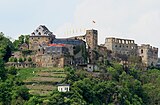 more pictures more pictures
|
| Monument zone core city St. Goar |
location |
ends in the north with the Catholic Church, from there meets the remains of the city wall on the hillside to the southwest, runs along the city wall to the modern round tower just before the tunnel, turns from there to the north-east of the Rhine and ends at the level of what is documented there , today no longer preserved city wall tower; on the Rhine, the border runs along the B 9 (mountain side) |

|
Individual monuments
| designation | location | Construction year | description | image |
|---|---|---|---|---|
| city wall | south of the city center location |
14th Century | get only the mountain side; northern wall move from the 14th century with three-story office tower and three-story witch tower, ruins of the pigeon tower in the southern half; New tower, 17th century; Nappenturm, three-story large log house; southern wall with bastion (called pate), after 1736 | |
| Viticulture Office | At the port 2 location |
1898 | former district court; three-storey plastered building, marked 1898 |

|
| Municipal school | At the port 4/6 location |
1901 | Late historical hipped roof building with corner projections, partly slated, partly half-timbered, 1901 |
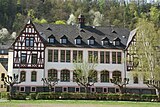
|
| Water police station | At the port 8 location |
1903 | representative gothic dwelling, marked 1903 | |
| Residential building | At the port 10 location |
around 1910 | Plaster construction on broken slate base, around 1910; overall structural system | |
| Caiman diving shaft | At the port, in the winter port location |
1892 | Diving shaft "Kaiman" of the Rheinstrombauverwaltung, built in 1892, the last of two former diving bell ships that were used between Cologne and Karlsruhe for work under water in the river bed |

|
| District Court | Bismarckweg 1/3 location |
1914-18 | former district office; New Baroque plastered building, 1914–18, side wing 1928 |

|
| Residential building | Grebelgasse 4 location |
1780 | three-storey half-timbered house, partly solid, plastered, hipped roof, marked 1780 | |
| House of Tusculum | Gründelbach 4 location |
1900 | representative house, partly with ornamental framework, winter garden, 1900; overall structure with garden | |
| villa | Heerstrasse 5 location |
1892 | representative house, partly with ornamental framework, marked 1892; garden |

|
| villa | Heerstrasse 9/11 location |
1879 | Half-timbered villa, Swiss style, marked 1879; Half-timbered garden house (No. 11) with deeply niched gable; overall structure with garden |
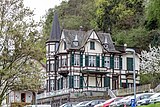
|
| Residential building | Heerstrasse 13 location |
around 1890 | Angular plastered building, around 1890 | |
| Tunnel portal | Heerstrasse, behind No. 15 Lage |
1857-59 | North portal of the bank tunnel of the railway line on the left bank of the Rhine, 1857–59, rich neo-Gothic architecture with battlements and turrets. Window with lancet arch . | |
| Loreley House | Heerstrasse 41 location |
18th century | Half-timbered house, partly solid, plastered, 18th century |
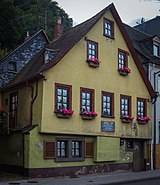
|
| railing | Heerstrasse, at No. 53 Lage |
second quarter of the 19th century | Cast-iron railing in classicist forms, Sayner Hütte , second quarter of the 19th century | |
| Residential and commercial building | Heerstrasse 59 location |
Late 18th century | Plastered building, essentially from the end of the 18th century, shop front from the 1930s; Half-timbered rear building, plastered; in the back yard elevator beams, quarry stone wall. From 1888 to 1990 the Rheinfels pharmacy was located there , and has been in St. Goar since 1598. |
|
| Hotel "Silver Rose" | Heerstrasse 63 location |
1524 | three-storey half-timbered house, partly massive, 17th century, in the core probably older (marked 1524) | |
| Hotel "Rheinfels" | Heerstrasse 69 location |
1789/90 | former hotel “Rheinfels”; four-storey, ten-axis plastered building on the eaves, 1789/90 by Johann Daniel Ilges | |
| "Rheinhotel" | Heerstrasse 71 location |
1789 | formerly the “Golden Chain” inn; three-storey plastered building, marked 1789 |

|
| Kreissparkasse | Heerstrasse 81 location |
1936 | thirteen-axis, three-storey plastered building, marked 1936 | |
| Hotel "Zum golden Löwen" | Heerstrasse 82 location |
1881 | three-storey half-timbered building, partly solid, plastered, 1881 | |
| Residential building | Heerstrasse 101 location |
16th Century | Half-timbered house, partly massive, marked 1675, possibly in the core from the 16th century, wooden sculpture |

|
| Residential and commercial building | Heerstrasse 114 location |
around 1870 | three-storey, gable-independent plastered building with main facade facing the Rhine, around 1870 | |
| Residential and commercial building | Heerstrasse 116 location |
second half of the 19th century | three-storey plastered building on the eaves with main facade facing the Rhine, second half of the 19th century; In the front garden wall: Grünewaldsbrunnen, marked 1722 | |
| basement, cellar | Heerstrasse, at no.120 |
two-bay cellar with groin vault, possibly medieval | ||
| Residential building | Heerstrasse 123 location |
1682 | three-storey half-timbered house, partly massive, marked 1682, older in the core | |
| town hall | Heerstrasse 130 location |
1880 | Brick building on a cross-shaped floor plan, mixed forms of neo-Gothic and neo-Renaissance, marked 1880 |

|
| Catholic parish church of St. Goar and St. Elisabeth | Heerstrasse 133 location |
1887-91 | neo-Gothic basilica, quarry stone, 1887–91, architects Heinrich Wiethase and Eduard Endler , Cologne; 1923 The tower of the previous Baroque building was included as a bell tower |
 more pictures more pictures
|
| front door | Herpellstrasse, at No. 2 location |
1784 | Front door with rocaille ornaments, 1784 | |
| Fountain | Church square location |
second half of the 19th century | Handle pump, probably from the Rheinböllener Hütte , second half of the 19th century | |
| front door | Church square, at No. 6 location |
1772 | double-leaf rococo door, 1772 | |
| basement, cellar | Market, in No. 1 location |
two-aisled cellar, probably medieval | ||
| Hotel "Am Markt" | Market 2 location |
1922 | former district electricity authority; Mansard roof building, 1922 | |
| Evangelical collegiate church | Market 3 location |
1469 | three-aisled late Gothic gallery hall, eastern part above Romanesque crypt, late Romanesque choir, choir flank towers, beginning of the tower extension marked 1469; extensive restoration, 1889–95, architect Heinrich Wiethase, Cologne |
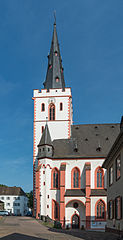 more pictures more pictures
|
| monastery | Market 4 location |
1724 | former monastery building, now tax office; fifteen-axis plastered building, essentially half-timbered, marked 1724, essentially older |

|
| Han fountain | Oberstrasse, opposite No. 3 location |
1788 | Well chamber in broken slate wall, marked 1788 | |
| Residential building | Oberstrasse 15 location |
1749 | nine-axis hipped roof, marked 1749 | |
| Residential building | Oberstrasse 16 location |
Mid 18th century | three-storey representative hipped roof building, middle of the 18th century, heightened in the 19th century; overall structure with garden | |
| Residential building | Oberstrasse 19 location |
Late 18th century | Mansard roof, half-timbered cladding, end of the 18th century | |
| Residential building | Oberstrasse 20 location |
1764 | six-axis hipped mansard roof, marked 1764 | |
| front door | Oberstrasse, at No. 26 Lage |
second half of the 18th century | Rococo skylight door, second half of the 18th century | |
| House Napp | Oberstrasse 27 location |
1780 | Mansard roof building with a former manufacturing area, plastered half-timbering, marked 1780 | |
| Sankt Goar train station | Oberstrasse 32 location |
1860 | expressionist quarry stone building, 1926–28; Goods handling hall, 1909/10 |
 more pictures more pictures
|
| "Hoffmanns Weinstube" | Oberstrasse 34 location |
1929 | Quarry stone construction, 1929, with parts from the previous 17th century | |
| "Old Weinstube zur Krone" | Oberstrasse 38 location |
18th century | Half-timbered building, partly massive, 18th century | |
| Residential building | Oberstrasse 39 location |
Early 20th century | three-story house, partly half-timbered, early 20th century | |
| front door | Oberstrasse, at No. 46 Lage |
18th century | two-part skylight door with rocailles, 18th century | |
| Residential building | Oberstrasse 77 location |
1891 | neo-Gothic brick building, 1891 | |
| Fountain | Pumpengasse, at No. 4 location |
second half of the 19th century | Handle pump, probably from the Rheinböllener Hütte, second half of the 19th century | |
| Fountain | Pumpengasse, opposite No. 7 location |
second half of the 19th century | Handle pump, probably from the Rheinböllener Hütte, second half of the 19th century | |
| Residential building | Schleiergasse 9 location |
18th century | Half-timbered house, partly solid and slated, 18th century; Complete structural system with brick barn, around 1900 | |
| Tomb | Schlossberg, on the cemetery location |
Böcking tomb, angel with anchor | ||
| Residential building | Sonnengasse 6 location |
1779 | three-storey half-timbered house, plastered, marked 1779 | |
| Syringe house | Sonnengasse 8 location |
1750 | former syringe house; Half-timbered building, partly solid, plastered, mansard hipped roof, marked 1750 |
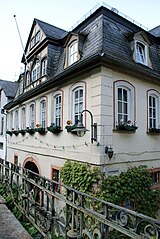
|
| Tunnel portal | southeast of the city location |
1857-59 | South portal of the bank tunnel of the railway line on the left bank of the Rhine, 1857–59, rich neo-Gothic architecture with battlements and turrets |

|
Biebernheim
Individual monuments
| designation | location | Construction year | description | image |
|---|---|---|---|---|
| Fountain | At the Bach, corner of Linnengasse Lage |
second half of the 19th century | Handle pump, cast iron, Rheinböllener Hütte, second half of the 19th century | |
| Residential building | Dorfstrasse 2 location |
early 18th century | Half-timbered house, early 18th century | |
| Protestant church | Dorfstrasse 8 location |
1702-05 | Mansard roof building with trapezoidal choir, 1702–05, with parts of the predecessor; overall structural system with surrounding area |

|
| Fountain | Kuhweg location |
second half of the 19th century | Handle pump, cast iron, Rheinböllener Hütte, second half of the 19th century |

|
| Residential building | Linnengasse 52/54 location |
18th century | two-wing half-timbered building, hipped roof, 18th century | |
| Catholic chapel of St. Maria Regina and St. Leonhard | Ringstrasse 9 location |
1954-56 | single-aisle hall building with facade tower, concrete, 1954–56, architect F. Ritter, Spay |

|
Skins
Individual monuments
| designation | location | Construction year | description | image |
|---|---|---|---|---|
| milestone | on the B 9 towards St. Goar Lage |
1818 | Prussian milestone , obelisk with side benches, basalt, 1818 |

|
Werlau
Monument zones
| designation | location | Construction year | description | image |
|---|---|---|---|---|
| Monument zone Forsthaus Brandswald | northwest of the village location |
early 19th century | includes the forester's house (see there), farm wing, barn, bakery, well and garden, fenced with hedges |
Individual monuments
| designation | location | Construction year | description | image |
|---|---|---|---|---|
| Evangelical St. George Church | Kirchstrasse location |
1692-98 | Hall building, 1692–98, enclosing walls of the medieval predecessor, tower 1789–91, prayer room 1892, reconstruction, new construction of the tower, 1906/07 | |
| Residential building | Kirchstrasse 11 location |
18th or 19th century | plastered half-timbered house, 18th or 19th century | |
| Evangelical rectory | Rheingoldstrasse 52 location |
1832/33 | former evangelical rectory; Classicist hipped roof building, clad (half-timbered?), 1832/33, building inspector Ferdinand Nebel , Koblenz | |
| Forester's lodge Brandswald | northwest of the village location |
early 19th century | Quarry stone building, early 19th century |
literature
- General Directorate for Cultural Heritage Rhineland-Palatinate (Ed.): Informational directory of cultural monuments in the Rhein-Hunsrück district (PDF; 1.7 MB). Mainz 2017.
Web links
Commons : Cultural monuments in Sankt Goar - Collection of pictures, videos and audio files
- Geoportal Rhein-Hunsrück - Map with the cultural monuments in the Rhein-Hunsrück district
Individual evidence
- ^ Commemorative publication on the 100-year family property of the Rheinfels pharmacy
- ↑ District administration Rhein-Hunsrück-Kreis: Statutory ordinances on the protection of monument zones in the Rhein-Hunsrück-Kreis (PDF; 49 kB); Retrieved October 18, 2011